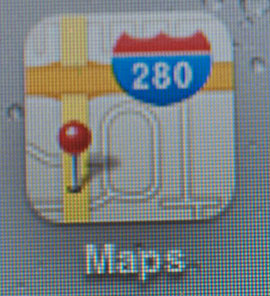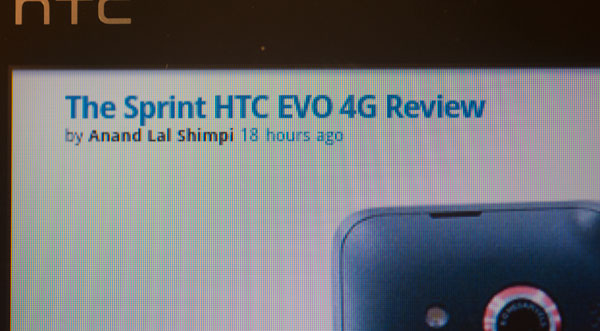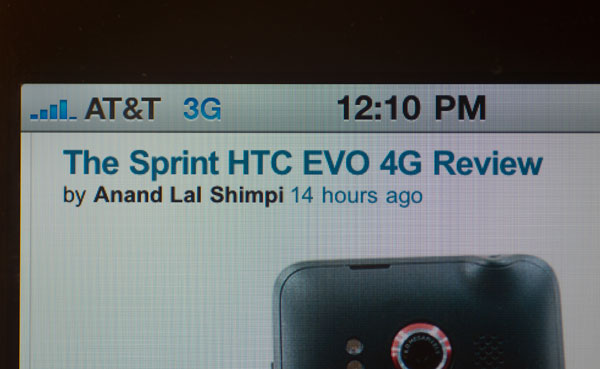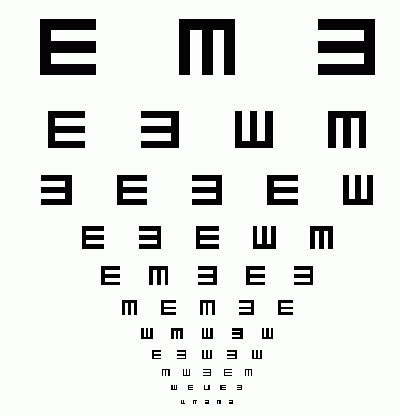Apple's iPhone 4: Thoroughly Reviewed
by Brian Klug & Anand Lal Shimpi on June 30, 2010 4:06 AM EST- Posted in
- Smartphones
- Apple
- iPhone 4
- Gadgets
- Mobile
Screen - Retina Display
Right out of the box, the iPhone 4's new 326 PPI, 960x640, 3.5" display is arguably the single most striking change the new iPhone brings. In a word, it's dazzling. Text and high res images look amazingly sharp on the iPhone 4’s retina display. It’s an improvement over the 800 x 480 AMOLED screens that have been shipping on most Android phones. But if you’re comparing it to an iPhone 3GS the difference is huge.
 |
 |
|
iPhone 3GS
|
iPhone 4
|

Text on the Google Nexus One

Text on the iPhone 4
The dot pitch is truly remarkable, so much so that Apple makes the claim that their display outresolves the human eye; its advertised ability to do so has earned it a new Apple tradename, "retina display."

Text on the HTC EVO 4

Text on the iPhone 4

AnandTech Logo on the EVO 4G

AnandTech Logo on the iPhone 4
Immediately after hearing Apple's claim that the Retina Display outresolves the human eye, I snapped into optics mode and crunched the numbers, and tweeted that the results were valid.
In the days that followed, there was considerable debate about the validity of Apple's claims. However, nearly all of the debate really just hinged on a debate over angular resolution of the human eye, and a little more over viewing distance. They're both entirely conventions.
As you've probably discovered by now, the human eye resolution can really only be characterized in angular subtense. Hold something closer to your eye, and you can see smaller features better (in theory), move it further away, and you can't make out small spatial details. The minimum angle visible with the human eye is the angle at which features (for the most common definition, a black and white square wave) stop being visible, and are indistinguishable from each other.
Most measures of visual acuity test with this implicitly - the Snellen eye chart's use of the capital "E" is literally a perfect example, which has given rise to a "tumbling E" eye chart. At twenty feet, the capital E subtends 5 minutes of arc, and conveniently has five half cycles of white to black (from top to bottom). So 20/20 implicitly implies an angular resolution of 1 arcminute (1/60 degrees).

As an Optical Sciences and Engineering undergrad, I've had 1 arcminute drilled into my head more times than I can count as being the "normal" angular resolution of the human eye system. In practice, this is 20/20 vision, which is "normal," yet not perhaps the absolute maximum for human perfection. We can play games of course and argue that a small subset of the population has better than normal uncorrected vision, and thus an angular resolution of below 1 arcminute. I have above average uncorrected vision, which I've measured to be 20/15 on average, giving an angular resolution of approximately 0.75 arcminutes. Of course, the definitions stem from the spacing of cones in the fovea, the highest resolution part of the retina.
The other informational quantity needed to test the Retina Display claims is viewing distance. Again, there's a commonly agreed upon convention - standard viewing distance is considered to be 1 foot. This is another drilled into my brain number tossed around for comfortable viewing and reading. In practice, you can focus on objects much closer to your eye - this is called the near point and is often given as 10 inches, though as you get closer you increase strain aren't likely to keep it here.

Maybe not exactly the limit, but close enough.
Given the two most common standards tossed around, 1 arcminute and 12 inches, do the math out and you'll arrive at around 286 pixels per inch as the limit for eye resolving power, comfortably below the 326 on the Retina Display. Move to 0.75 arcminutes at 12 inches, and it's 382 pixels per inch, higher than the Retina Display. Honestly, I can't see the pixels at 12 inches.
Of course, the real story is even more complicated. Remember how the definition comes with the implicit assumption that we're dealing with a square wave pattern from white to black? That's a factor too - the contrast of the two pixels. Lower the contrast, and the eye's ability to pick out features decreases even more. So far, everything we've talked about has been first order, and without aberrations. Toss in spherical and astigmatism, two aberrations common to the eye system, and eye performance drops way more.
The human eye system is actually pretty poor, and shockingly easy to outresolve. In fact, if you saw the image your eye forms on your retina, you'd likely be appalled; it's your brain that makes the system usable. But at the end of the day, Apple's claims that the display outresolves the human eye are good enough for us.










270 Comments
View All Comments
strikeback03 - Tuesday, July 6, 2010 - link
How does international work? Are other parts of Europe covered by that as well or are they all additional?B3an - Thursday, July 1, 2010 - link
Theres way WAY less options for network and internet providers in the U.S, especially compared to here in the U.K..So less competition means higher prices. And of course the size of the U.S/Canada is a problem.
strikeback03 - Thursday, July 1, 2010 - link
Some friends who have been living in England say that cell usage over there is way more expensive. They claim the only affordable way to do it is with pay as you go SIMs and just not use them much.But yes more competition would be nice. For me Verizon is the only carrier that offers the kind of coverage I need. So between the fact that I can't go anywhere and that they don't offer an off-contract rate I have no reason not to take the subsidized phones and contract extensions.
Chissel - Sunday, July 4, 2010 - link
I'm an American living in the UK. iPhone 4 rates here are much lower. The best I have seen is from Tesco (o2 network). Low cost no frills service. 750 minutes + unlimited texts + 1gb of data per month. Also, incoming calls do not charge minutes. 1 yr. contract 32gb iPhone 4 = £299/$450 + £35/$50 per month (all tax included). After 1 yr. they have to unlock your phone. After you unlock the phone you can drop down to £20/$30 per month.This means the 2 year cost of the phone + service in the UK is £959/$1,438. In the US the 2 year cost is $299 + tax and $105/mo + tax. Total cost over 2 years is $2,819 without tax.
As you can see the UK has much lower price over the 2 years. Plus, after 1 year you 'own' your phone and can resell and buy iPhone 5.
strikeback03 - Tuesday, July 6, 2010 - link
I think the unlock on AT&T can be requested after 3 months, definitely after a year as I had a friend do that.StormyParis - Saturday, July 3, 2010 - link
I've abandonned data plans, and switched back to plain voice, on my HD2. I get Wifi most everywhere (at home and at work for sure, and most places in between). I was simply not using data that much, it's not worth the monthly 30 euros they want for it.99.5% of the time, there's no difference at all. 0.5% of the time... i can survive...
vol7ron - Wednesday, June 30, 2010 - link
I agree, but..."The fact that Apple didn't have the foresight to coat the stainless steel antenna band with even a fraction of an ounce worth of non-conductive material either tells us that Apple doesn't care or that it simply doesn't test thoroughly enough. The latter is a message we've seen a few times before with OS X issues..."
Apple would just see this as another selling point for the bumper.
Anand/Brian-
I'm curious if you've had a chance to test with the microfilm covers like Bodyguardz or Zagg.
I use these because of how thin they are and how great they are at protecting the device (scratch free even when dropping on concrete). They cover all points of the phone rather effectively. I'm curious if they would be beneficial to your testing.
vol7ron
Brian Klug - Wednesday, June 30, 2010 - link
vol7ron,You're totally right, I need to test with a thin film or some heavy duty tape/invisible shield. I originally thought of doing that, but somehow it got lost in all that frenzied testing. I'll whip something up and see if anything changes. I mean that's a good point too, it might not do very much.
I mean, ultimately there's a thickness you do need to achieve, and to be fair a lot of the benefit the case adds is that extra couple mm or two from the antenna. If the film is too thin, it might not do much. What makes me uneasy about saying anything definitively is that this is so near field - literally on top of the radiative surface. I'll admit I have only a basic level of understanding about what kind of interference happens in the very near field. I mean even at 1.8 GHz, one wavelength is 16 cm - the case and your hands on the phone is way inside near field.
-Brian
rainydays - Wednesday, June 30, 2010 - link
Agree. Outstanding review. The detailed analysis and level headed tone is excellent. Keep up the great work.Antenna section was illuminating. Good point about using SNR. I wonder if that number by itself is sufficient though. I guess signal power in dbm along with SNR would give the most complete picture of reception.
At any rate, as is abundantly clear in the article, you never really know where you are till you see the numbers.
John Sawyer - Thursday, July 1, 2010 - link
Yes, the numbers, details, etc. are more important than a lot of people realize. It often annoys me when I see people commenting about issues that involve actual measurement, technical facts, etc., without referring to any of those, and thus winding up with all kinds of conspiracy theories, bogus suggestions, etc. As applied to hardware problems from any manufacturer, generally many such commenters, in their understandable desire to just see a fix for a problem, wind up suggesting the only important thing is for the manufacturer to set up a return exchange program, which would be nice if it were always that easy, but it doesn't address the details of the problem that are often quite interesting, and can be very useful for people trying to learn from the situation.